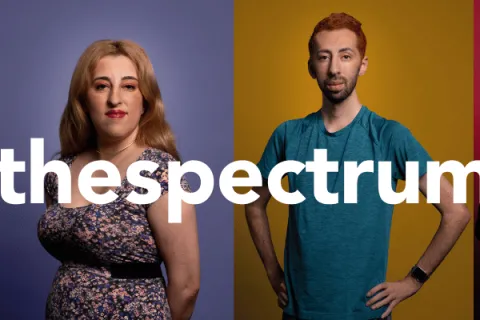Autism in adult women: 'You don't seem autistic to me'
By Valerie ParadizThis is a post by Autism Speaks Board Member Valerie Paradiz, Ph.D. Dr. Paradiz is the director of Valerie Paradiz, LLC, a consultancy that provides technical assistance and strategic development to schools, universities, corporations and agencies that support individuals with autism.
“You don’t seem autistic to me.”
I hear these words often. Sometimes they are said in disbelief or outright mistrust. This skepticism might come from good friends or co-workers in the disability fields. I even hear it from some parents of children on the spectrum who attend my conference presentations or from special educators I train in sensory and social supports for students in their classrooms. It’s been 12 years since I was diagnosed with autism when I participated in a study at New York University Hospital. Although I’ve earned the badge of veteran to my diagnosis, I still have days when I wish I had a tougher skin. My invisibility as a person with autism is due in large amount to the fact that I am female.
Autism is not a male condition
My situation is no different than the women and girls who have had the fortune of being evaluated by the few skilled clinicians who bravely question the current reported ratio of males to females with autism. (According to the U.S. Centers for Disease Control and Prevention, while nearly 1 in 42 boys are diagnosed with autism in the U.S., the number is about 4 times lower in girls at 1 in 189.) Without such specialists, I would have continued bumbling along in my life, moving as I had done for decades from therapist to therapist in treatment for depression yet never really getting to the heart of the matter: my autism.
Having a diagnosis was life-changing. I now know I must go to therapists who use methods I respond to best. Visual supports and concrete scenarios during talk-therapy sessions, as well as cognitive behavioral therapy, have helped me become a happier, more productive person.
For those of us who count among the reported numbers of females with autism, accessing support and effective treatments can be as much of a challenge as is being taken for our word when we dare to disclose our condition to others. I must add to this the unknown numbers of women and girls who remain overlooked or misdiagnosed, those who aren’t receiving the support they need.
Invisible autism
As an undergraduate in college at CU Boulder, I was a bit of a loner. I had one close girlfriend who was a foreign language nerd like me. After Russian class, we would hike in the lovely foothills of Boulder conjugating verbs for one another in all the other languages we knew—French, German, Dutch, Spanish. Or we would spend hours comparing the rules and exceptions of the pronoun systems of various languages. Our conversation was rarely personal. We didn’t speak about guys or clothes or how we did our hair. In fact, I recall not combing my hair for days at a time and wearing the same favorite pair of shorts for weeks on end.
I avoided parties like the plague, and I studied all the time. I was a straight A student and a perfectionist. I kept rigid routines, which helped me cope, but they also caused me tremendous anxiety. Often I studied longer than I needed to, as a way to avoid interactions with other students who lived in my dorm. Such encounters made me nervous. I didn’t know how to participate and worried constantly about saying the wrong thing. My dorm mates called me “shy” and “nerdy”. I was able to be affable, but it was exhausting.
Masters of camouflage
I experienced my first severe depression in my junior year of college, and today I often wonder whether my foreign language friend, with whom I’m no longer in contact, was a master of camouflage just like me. Before college, life in high school had been easier. I had three sisters all close in age. They paved the way for me socially because they were popular girls. Long hours of watching them curl their hair and put on makeup in the mirror while they talked about boys taught me how to “pass”. I learned how to mimic what was necessary to get through the day and to maintain the friendships that I had.
In the autism literature that concerns itself with female social interaction, this is sometimes referred to as “camouflaging”, or a tendency to cover up difficulties by “masking and/or developing compensatory strategies” (Lai, et. al., Journal of the American Academy of Child and Adolescent Psychiatry, Volume 54, Number 1, January 2105, p. 13). Additional social-communication traits distinctly attributed to us ladies include being loners, or being thought of as shy; having a greater awareness than males with ASD of the need for social interaction; having better linguistic ability; and tending to imitate others in social interactions, which can be fatiguing. (ibid.)
As we do this, we also tend to be scripted or overly controlled in our interactions, sometimes to the point of becoming nonreciprocal with others. While I was in high school, I took very long walks alone on the prairie of Pueblo, Colorado where I grew up. As I walked I would assiduously review my social interactions at school that day, repeating the words I said to others over and over again aloud to myself. I also would recall what others had said to me and speak their words aloud, too. This was my method of trying to divine whether I had made a social mistake earlier that day. The process was arduous, but it assisted me in learning the skill of camouflage. I still do it today when I am going through nervous or difficult periods with co-workers or close relationships.
I count myself among the subgroup of females with autism who “have verbal intellectual abilities in the average to superior range” and have the “ability to mimic others’ behavior,” as Dr. Shana Nichols, director of ASPIRE Center for Learning and Development in Melville, New York describes us. Yet our very strengths also contribute to our “flying under the radar,” thereby not catching the attention of professionals or others in our lives who would be in a position to identify symptoms of ASD.
Thankfully, heartening reports published this year have uncovered a long-standing male bias in research and in diagnostic methods of autism that has gravely influenced the detection and understanding of girls and women. “Autism should not be perceived as a ‘male condition’,” say a team of the world’s top autism researchers, observing a slow-moving trend across the past two decades “towards a decreasing male-predominance” (Molecular Autism, 2015 (6:24) 1).
I am hopeful for the future that women with autism will have when research and diagnostic methods have evolved to incorporate sex and gender considerations with less bias than they have since the first descriptions of autism in the 1940s. I will know we have arrived when a girl or woman newly diagnosed with autism does not have to hear the words, “You don’t seem autistic to me.”









